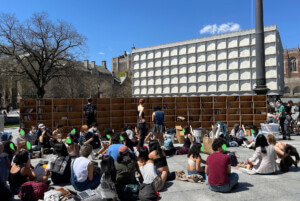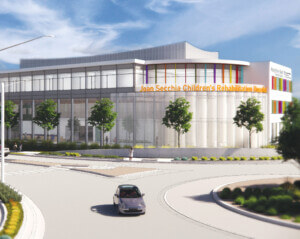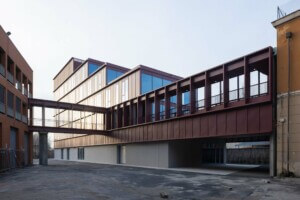Over the past summer, we have seen a litany of public statements against racism in support of Black lives from companies that have never before taken a race-related public position. In my employer’s statement, SmithGroup, one of the largest architecture firms in the country, denounced “the continual dehumanization and compromised safety of communities of color.” This brought a visceral sense of irony within me as I protested against police brutality in front of the Detroit Public Safety Headquarters, a SmithGroup-designed project.
As I watched dozens of cop cars released from this building, headed to assault protesters and arrest over 100 peaceful protesters, I wondered, “How can you support Black lives but also design police stations?”
Angela Davis said, “if we want to imagine the possibility of a society without racism, it has to be a society without prisons. Without the kind of policing that we experience to date.” SmithGroup and many other firms have decided to “reject any work in planning and designing jails, detention centers, and prisons.” But this is not enough.
The American Institute of Architects still supports designing prisons. Its code of ethics, according to its former president Helene Combs Dreiling, “isn’t about what architects build.” Individual firms have had to stand against designing prisons and detention centers. But when city governments invest over a third of funds into the police system, how can firms turn down high-profit work for multi-million dollar police stations?
Shortly after SmithGroup’s statement was released, one of SmithGroup’s Black designers resigned after he was tasked to work on the Kenosha County Campus and after learning that his firm designed the Detroit Public Safety Headquarters. In a New York Times interview, he said, “These project types are the literal structures of structural racism against Black people in the United States.” In SmithGroup’s response to The Cap Times, managing partner Troy Thompson explained that the project focused on repurposing existing buildings with holding cells to support social services, and that the firm’s work with police and court facilities was limited.
Of course, there was no acknowledgment of Kenosha County having the highest incarceration rates of Black people in Wisconsin, or the high Black/White ratio of prison admissions. How can this be anything other than an attempt to remove ourselves from accountability for the greater narrative that these facilities play in the mass incarceration of Black people?
Is it possible to design a police station so equitable, sustainable, and fitted with social services, that it becomes an asset and increases the sense of safety for a community? As architects, we often idealize the power of buildings, believing that our design prowess can influence a positive culture of fairness and justice. But unless architects serve a client whose value system is aligned with theirs, their only influence is in the physical and spatial qualities of the structure; how the building is used is out of their control.
In 2014, SmithGroup designed the new Detroit Public Safety Headquarters, which “sought to create a national model for public safety integration” and houses “police, fire, homeland security, a state-of-the-art forensics lab, information technology services and more.” The building was lauded for being LEED Silver, saving taxpayers “tens of millions of dollars” by repurposing an existing casino, and it even won an AIA Detroit Honor Award.
I have no doubt the intentions were good; after all, we often hear, “If we don’t design it, someone else will.” But why wasn’t the Public Safety Headquarters atomized as smaller, approachable community centers within the neighborhoods? Why was it designed as an unapproachable fortress in downtown Detroit, a part of the city where parking is difficult, navigating the far-removed entrance is cumbersome, and the perception of the building is more of a complex rather than a community asset? The Public Safety Headquarters cannot “create a national model for public safety integration” when it has become a storage facility for military-grade equipment, surveillance, and hundreds of cop cars.
Over the past decade, Detroit’s Black and Brown communities have been stripped of housing, healthcare, education, and recreation. Meanwhile, 42 percent of the Detroit General Fund spending is allocated to the police ($294 million in total) which has fortified policing in these neighborhoods. This is both a response to the crisis created by stripping away social services as well as a for-profit method to replace slavery through the mass incarceration of Black lives in labor camps, which has become an $80 billion industry. In other words, the police system as it stands today was created to replace slavery. The system is not broken; it’s working exactly as it was designed.
The situation becomes even more oppressive, since 87 percent of cops live outside of the City of Detroit, creating a dominant/subordinate model between White cops and Black and Brown residents, where the cops, who are unfamiliar with the residents, are trained to treat each encounter as a potential threat. These 1,892 city employees take their paychecks, pensions, retirement funds, outside of the city and into the suburbs.
If we take this into consideration, along with the history of redlining, erasure of Black Bottom and other Black neighborhoods, and the presence of gated communities, we begin to understand what W. E. B. Du Bois described as double-consciousness, where Black people have to continuously monitor how their presence is perceived by White people. Any act of joy or a glimpse of entitlement and rights by Black people, such as dancing or bird watching, can be responded to with violence by police and White vigilantes.
Black people are constantly surveilled by thousands of cameras across Detroit through a faulty, racist surveillance system that costs millions of dollars (with its technology housed in the award-winning Public Safety Headquarters). Black people have been arrested and held in jail without explanation and for no reason, as we recently saw with Robert Williams and Michael Oliver.
Even though Detroit police chief James Craig has said that the police have added layers and protocols to the system, its software misidentifies Black people up to 100 times more than White people, getting it wrong 96 percent of the time. The Detroit Police Department (DPD)’s response to this is to only use facial recognition software for violent cases. But this means that the risk and impact of false imprisonment is much worse, as the punishment for violent crimes is more severe.
The extent of over-policing and brutality of Black and Brown bodies is unimaginable. DPD has killed nine (if not ten) people since 2015, has used illegal chokeholds on peaceful protesters, and cop cars have plowed through protesters after the cops had blocked off the protesters’ route back to their cars. According to Violet Ikonomova, “The city paid out $19 million in police misconduct settlements between 2015 and mid-2018, and 64 officers were criminally charged.”
This is unsurprising given the extensive militarization of the police through the 1033 Program, where surplus military equipment is donated to local police departments. This equipment includes mine-resistant vehicles, riot training suits, helicopters, and M16 semi-automatic assault rifles.
The Detroit Board of Police Commissioners, a citizen oversight group for the DPD, has refused to hold the DPD accountable. Although many residents do not want to live in a lawless city, the current DPD is the epitome of lawlessness.
Yet, as architects, we tell ourselves we can solve these systemic issues by focusing on designing buildings and places, believing that if we make them beautiful, sustainable, and functional, they will benefit our communities. We saw that with the push for open and complete streets during the spring of 2020 when many of the streets were empty due to COVID-19. We mistakenly believed that bike lanes, outdoor dining, and open streets would improve the economy by reopening businesses.
Instead, this rushed approach threatened the lives of Black and Brown essential workers, the same workers that carry the highest health risk from COVID-19. These same open streets were later littered with rubber bullets and tear gas canisters used by police on people protesting against police brutality.
In addition to standing against work that contributes to racism, we need to intentionally focus on designing work that is anti-racist. This goes beyond community engagement by centering and representing Black, Brown, and Indigenous people in the work we do. A great example of this is Design as Protest (DAP), a Black-led organizing effort that is calling on firms and designers to work collectively to end the weaponization of architecture and urban planning as a tool of oppression.
Since our field is directly tied to how communities are designed, our civic duty is to enlighten our local municipalities on the importance of investing in buildings and city designs that promote the liberation of Black and Brown people: high-quality affordable housing, accessible healthcare and education, and truly public spaces where their bodies aren’t policed.
While I appreciate the steps that SmithGroup and other firms have taken by encouraging their individual employees to read books, participate in committees, and have “open discussions,” this is an insubstantial and misguided response. These tactics are glossing over the real issues of how ingrained racism is in our society and our industry. We don’t need to relegate antiracist efforts to a committee in order to realize that we need to hire, promote, and equitably pay Black designers.
To truly moderate these discussions and assess the validity of projects and clients, we need the help of trained agencies and collectives. As architects and engineers, we are not equipped or experienced in moderating discussions on race. We are not critical race theorists, psychologists, or social scientists. This also applies to how we can make our design processes more collaborative and interdisciplinary, extending our usual list of consultants to include critical race theorists and social scientists. These experts can help promote equity and inclusion, which could open new possibilities for socially guided projects with clients that have aligned values and aspirations.
My hope is that we can shift our work into more intentional strategies that focus on promoting the liberation and joy of Black people and marginalized communities. Since most firms are led and owned by White people (typically White men), we need to recognize our limitations in both our identities, experiences, and training, and seek diverse consultants that are trained to help us remove our bias, decenter ourselves, and work together in empathy. Through this we can begin to fully manifest the reparations needed to fix the immense disparities found in both our profession and in Black and Brown communities.
References:
Tawana Petty, “Defending Black Lives Means Banning Facial Recognition”
Violet Ikonomova, “What Defunding the Police Could Look Like in Detroit”
Dr. Destiny Thomas, “‘Safe Streets’ are not Safe for Black Lives”
Keeanga Yamahtta-Taylor, “A Class Rebellion: Keeanga-Yamahtta Taylor on How Racism & Racial Terrorism Fueled Nationwide Anger”
Laura Walker is an associate at SmithGroup and cofounding principal of Other Work, an arts-based experimental group focused on architecture and city-making that promotes liberation and justice for marginalized communities through spatial agency.










